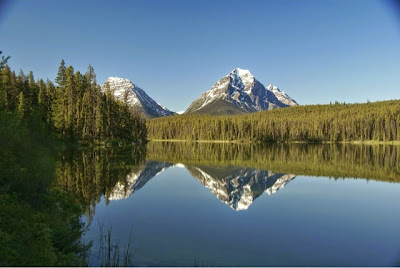It's one of the things about being a tourist, that you fee that you have to see the views in the brochures in order to feel that you have done the job properly and really have appreciated what the country has to offer. With this in mind we went on a boat trip along Maligne Lake - so called, we believe, because the horse of a French priest who was one of the first to travel through the country, slipped and was injured while crossing the river which he felt was malign.
The scenery was dramatic on all sides and a large number of photographs were taken by a small number of people. On the left of this picture is the biggest lump of rock I have ever seen. At the end of the lake, the boat pulled in to the side to allow us to disembark and take photos, and so a lot more Picts were taken. This one was taken before a young couple walked onto spirit island to collect their canoe and paddle back down the not inconsiderable length of the lake.
Imagine the frustration of some of the other members of the trip who had to take their photos with these inconsiderate people contaminating the foreground, although the young offenders had had the consideration to park their canoe on the far side of the island where it was out of shot.
So we can now relax as we have the iconic image, but the difficulty here is that there are views of mountains and water everywhere – so much so that we are perhaps beginning to suffer from scenic indigestion. As long as the sun shines, there are scenes like this everywhere.

















































